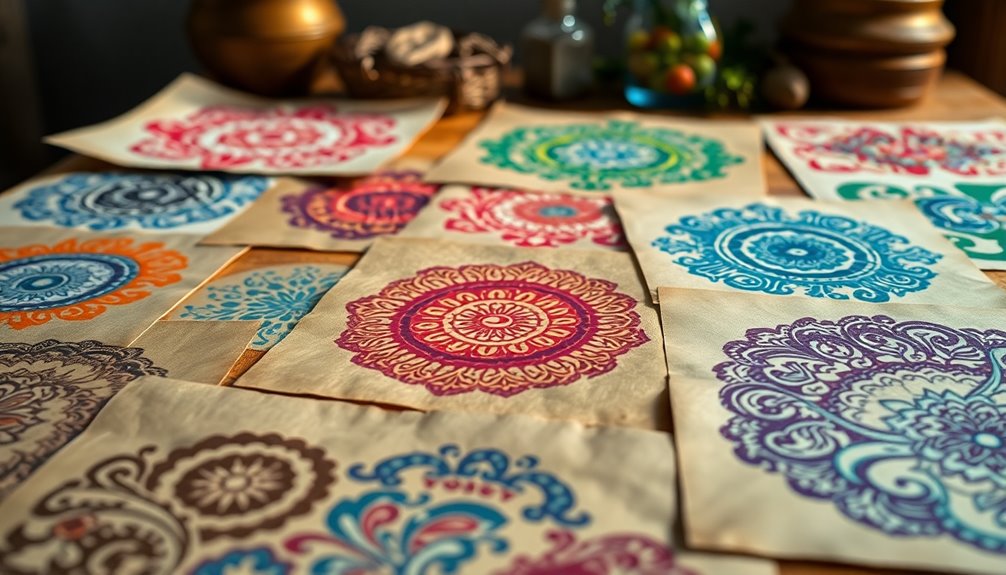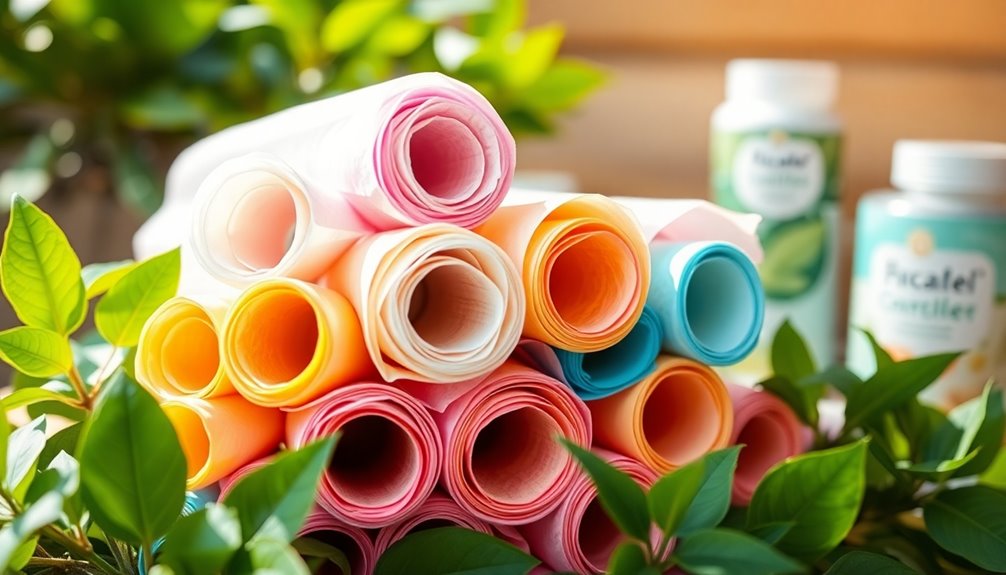When you see grams on paper, it refers to grams per square meter (GSM), which tells you about its weight and thickness. A higher GSM means sturdier and more durable paper. For instance, everyday documents usually range from 70 to 90 GSM, while business cards often go above 200 GSM for a premium feel. Choosing the right GSM is essential, as it affects both the quality of your printed materials and their functionality. Understanding how to select the appropriate GSM will help you meet your specific project needs more effectively. There's much more to explore about paper weight and its applications!
Key Takeaways
- GSM stands for grams per square meter, indicating the weight and thickness of paper.
- Higher GSM values correlate with sturdier, more durable paper suitable for various applications.
- Common GSM ranges include 70-90 for everyday documents and 200-300 for business cards.
- The choice of GSM affects the quality, functionality, and aesthetic appeal of printed materials.
- Selecting the appropriate GSM is crucial for ensuring effective performance based on project requirements.
Definition of GSM Paper
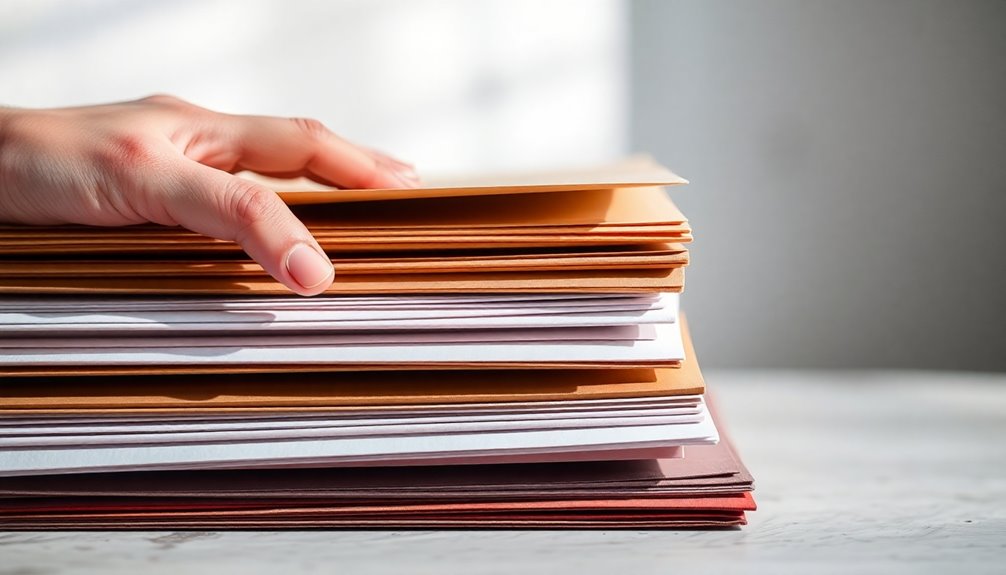
When it comes to understanding paper quality, GSM, or grams per square meter, is an important measurement that you should know. GSM indicates the weight of paper, providing a standard way of measuring paper weight across various paper types. Fundamentally, it tells you how much a square meter of paper weighs, which directly influences the paper's thickness and durability.
For instance, if you're considering a flyer, a 150gsm option is generally seen as thin, while a 250gsm flyer is thicker and more rigid. This difference in GSM makes the 250gsm paper suitable for premium applications like business cards or high-quality brochures. The higher the GSM, the more substantial the paper feels, which often correlates with a higher perceived quality.
One key advantage of measuring paper weight in GSM is that it allows for uniform comparisons across different paper types. Regardless of the paper's actual dimensions, the GSM remains constant, ensuring you can easily determine which paper will best meet your needs.
Understanding GSM helps you make informed choices when selecting the right paper for your projects.
Importance of Paper Weight

Understanding paper weight is vital for anyone involved in printing or design, as it greatly impacts the final product's quality and functionality.
Paper weight, measured in grams per square meter (gsm), indicates how heavy and thick the paper is, which directly affects its durability and suitability for various applications. For instance, heavier paper weights above 200 gsm are perfect for projects that require sturdiness, like business cards and postcards. On the other hand, lighter weights, typically ranging from 70-100 gsm, are used for standard printing tasks such as flyers.
Choosing the right paper weight is important for artists and designers, as it influences how well the paper handles different media, whether wet or dry. A heavier paper often conveys a sense of quality, making it ideal for long-lasting products like brochures and menus.
Conversely, lighter options may be more appropriate for single-use items. By selecting the appropriate paper weight, you guarantee that your printed materials perform effectively for their intended use, enhancing both the look and feel of your projects.
Keep in mind that the right paper weight can make all the difference in achieving the desired impact.
Types of Paper and GSM
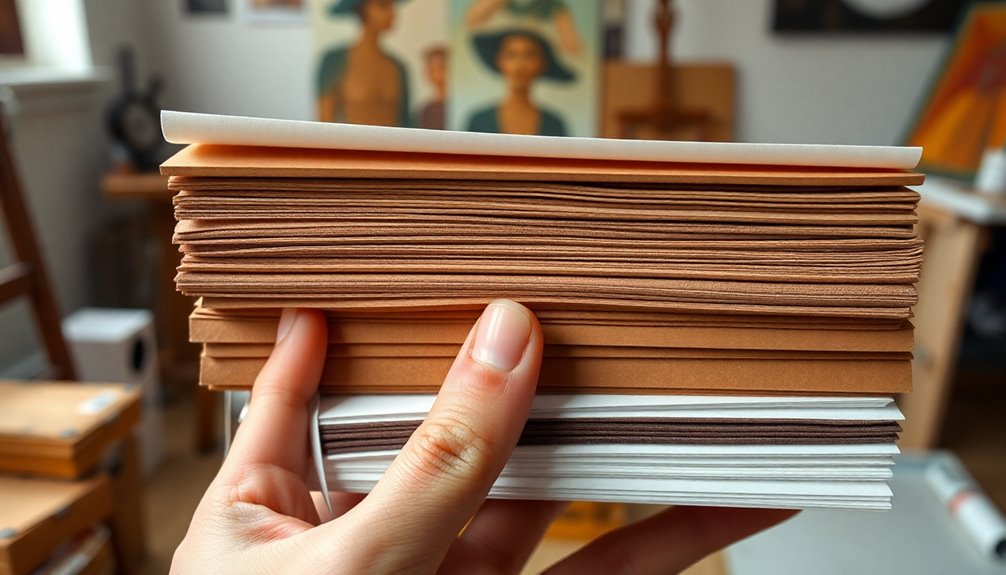
When you choose paper, it's essential to understand the different types and their GSM ratings.
Each paper type, from Bond to Cover stock, serves a unique purpose and impacts your project's overall quality.
Knowing the weight measurements helps you select the right paper for your needs, ensuring your printed materials perform as intended.
Common Paper Types
Paper comes in various types, each tailored for specific purposes and characterized by its weight and size. Understanding the different paper weights and GSM Paper can help you choose the right paper stock for your projects.
Bond paper, typically weighing 20 or 24 lbs, is ideal for everyday printing and has a basis size of 22×17 inches.
On the other hand, Book/Offset/Text paper, with a larger basis size of 38×25 inches, is great for books and catalogs.
Cover stock is heavier and stiffer, making it perfect for business cards and brochures, featuring a basis size of 26×20 inches.
If you're looking for something even sturdier, Index paper is your go-to option. It's 50% heavier than Cover stock and often used for index cards, with a basis size of 30.5×25.5 inches.
When selecting paper, keep in mind that the thickness and GSM can greatly impact usability.
Each type of paper stock serves unique functions, so understanding their characteristics guarantees you pick the right one for your needs.
Purpose of GSM
In today's world of printing, knowing the purpose of GSM is essential for achieving your desired results. GSM, or grams per square meter, measures the weight and thickness of paper, helping you determine its density and quality. Selecting the right GSM is vital for various projects, as it directly affects durability and appearance.
Here's a quick reference table to help you understand different types of paper and their recommended GSM:
| Paper Type | Recommended GSM |
|---|---|
| Tissue Paper | 10-70 gsm |
| Standard Office Paper | 70-100 gsm |
| Greeting Cards | 250-350 gsm |
| Business Cards | 200+ gsm |
Thicker paper, usually with a higher GSM, offers sturdiness, making it suitable for items like business cards and quality flyers. On the other hand, thinner papers are perfect for lightweight flyers and more delicate applications. By understanding the purpose of GSM, you can make informed choices that enhance the overall impression of your printed materials.
Weight Measurement Importance
Understanding weight measurement is essential for selecting the right type of paper for your projects. GSM, or grams per square meter, provides a consistent standard to gauge paper weight across various types. This measurement helps you determine the thickness and sturdiness of the paper you need.
For instance, typical office papers usually range from 70-100 GSM, while heavier cardstock can exceed 200 GSM.
When you're looking for materials like business cards, you'll want to choose heavier GSM options, commonly around 350-450 GSM. This weight gives your cards a card-like feel and enhances their durability, making a great impression on clients or customers.
The higher the GSM, the more quality you can generally expect, which is crucial for applications such as high-end marketing materials.
Selecting the Right GSM
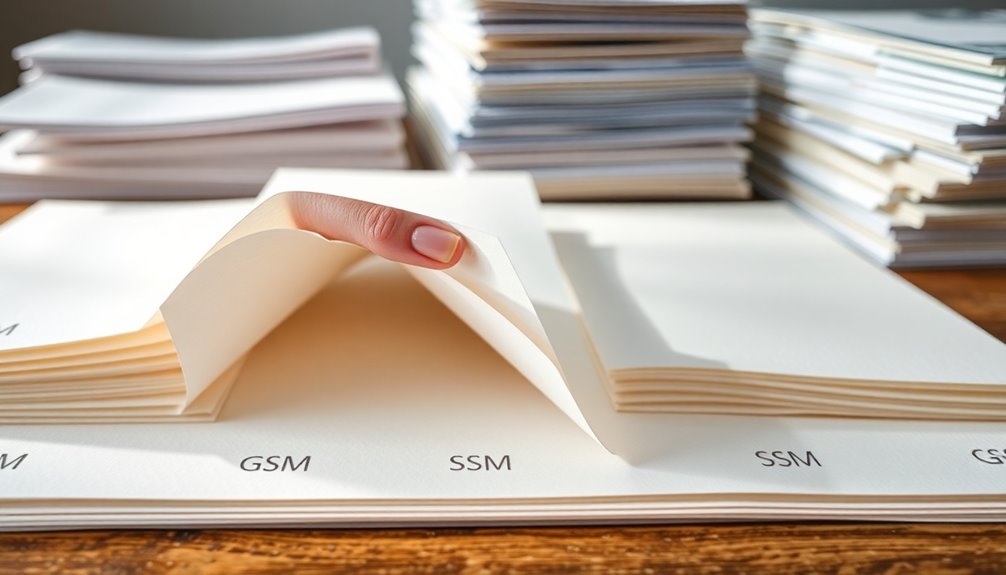
When you're selecting the right GSM for your project, it's important to understand how different weights affect your printed materials.
Consider the purpose of your paper; lightweight options are great for everyday use, while heavier stocks elevate quality for special items.
Don't forget to factor in cost, as investing in higher GSM can enhance both durability and presentation.
Understanding GSM Values
Choosing the right GSM for your paper can make a significant difference in the final product's quality and functionality. GSM, or grams per square meter, measures the weight of your paper, with higher values indicating thicker and more durable options.
For everyday printing needs, papers around 70-90 GSM are commonly used, making them cost-effective for items like office documents and flyers.
If you're looking for something sturdier, consider papers with a GSM between 200-300. These are ideal for quality brochures and covers, providing a more premium feel.
When you venture into the 300-350 GSM range, you're entering thicker card stock territory, perfect for items like business cards and postcards that require a solid presence.
Ultimately, selecting the right GSM involves understanding your project's needs. If you're creating something meant for long-term use, heavier stocks are the way to go.
On the other hand, if it's a single-use item, lighter papers will serve you well without breaking the bank.
Purpose of Different GSMs
Selecting the right GSM for your paper is essential for achieving the desired functionality and appearance of your printed materials. The weight and thickness of the paper directly influence its usability and aesthetic appeal.
Here are some key considerations for choosing the appropriate GSM:
- Business Cards: For items like business cards and postcards, opt for 350gsm. This thickness provides durability and a premium feel that leaves a lasting impression.
- Flyers: Lightweight flyers and takeaway menus typically use 120-150gsm. This GSM strikes a balance between durability and cost-effectiveness, making it ideal for bulk printing.
- Letterhead: When it comes to letterhead paper, aim for a GSM of 100-120. This guarantees printer compatibility while conveying a sense of quality.
- Posters: For posters or promotional materials that require sturdiness, a higher GSM will enhance their longevity and visual impact.
Ultimately, the GSM you select should align with the intended use and lifespan of your printed materials, guaranteeing they meet both functional and aesthetic needs.
Cost Considerations for GSM
Cost efficiency plays an essential role in determining the right GSM for your printed materials. When you're weighing your options, consider how the GSM affects overall costs. Lower GSM papers might reduce production expenses, but they could compromise the durability and quality you expect.
For instance, using 120gsm for one-time event flyers may save you money, whereas investing in a sturdier 350gsm for long-term materials like exhibition displays can be justified.
Thicker stocks, typically in the 200-300gsm range, often convey a higher quality perception, making them preferable for business cards and postcards. These items play a vital role in branding, so prioritizing quality could enhance your image considerably.
Before settling on a GSM, assess the intended use and lifespan of your printed materials. While heavier stock may cost more upfront, it often leads to better performance and greater customer satisfaction in the long run.
As a result, the choice of GSM should strike a balance between cost considerations and the desired quality and functionality, ensuring your selections meet the specific requirements of the project without exceeding budget constraints.
Cost Implications of GSM
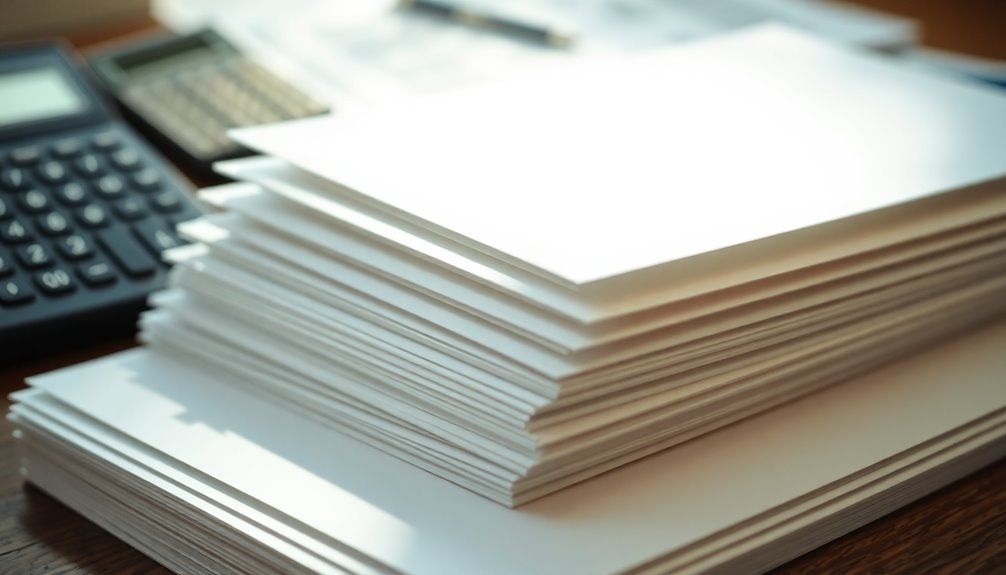
When it comes to paper, understanding the cost implications of GSM (grams per square meter) is essential for your project's budget. Higher GSM paper typically costs more due to its increased material density and durability.
Here are four key points to weigh:
- Investment Justification: Thicker papers, like 350gsm, can enhance perceived quality, making them worth the extra cost for reusable materials such as menus.
- Production Techniques: Papers above 200gsm often require enhanced production methods, which contribute to their higher prices compared to lighter stocks (70-90gsm).
- Shipping Costs: Printing on higher GSM paper might lead to additional shipping expenses due to increased weight and bulk, impacting your total budget.
- Long-term Savings: Investing in higher GSM can lead to greater satisfaction and reduced replacement costs, especially for items with a longer lifespan.
Practical Applications of GSM
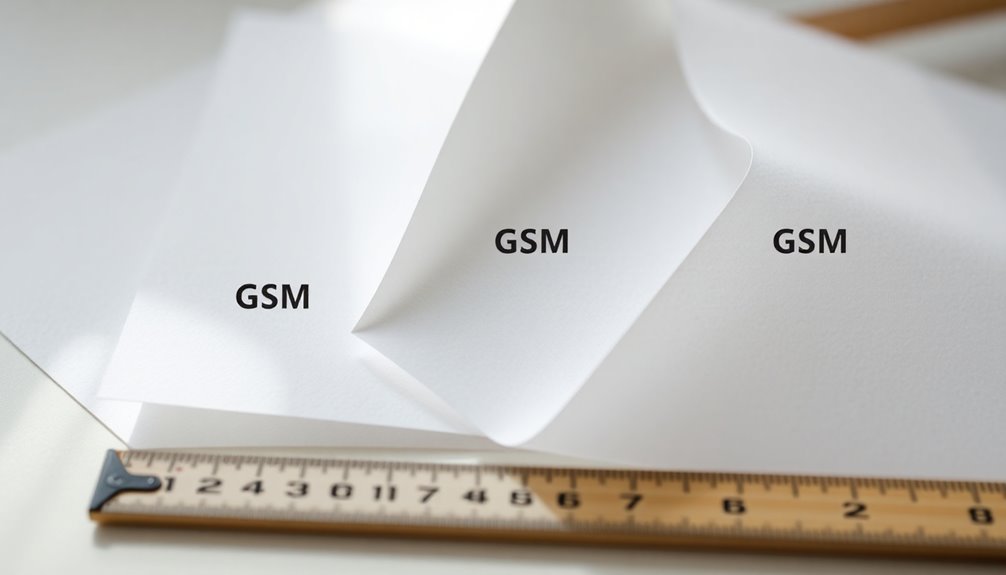
Understanding the implications of GSM not only helps with budgeting but also guides the practical applications of paper in various contexts. When you choose a paper type, consider its GSM, as this measurement indicates both weight and thickness.
For instance, if you're designing flyers or brochures, opt for paper with a GSM between 120-150. This range strikes a balance, making your promotional materials flexible yet durable.
For items like business cards and postcards, you'll want to select heavier GSM papers, typically exceeding 200. These thicker and stiffer options not only provide a premium feel but also resist wear, ensuring your cards leave a lasting impression.
On the other hand, if you're printing everyday documents, papers with a GSM of 70-90 are ideal. They're cost-effective for letterhead and internal paperwork without sacrificing functionality.
Ultimately, your choice of GSM directly influences the intended use of your printed materials. Thicker stocks are better for items needing longevity and a professional appearance, like menus and reports.
Frequently Asked Questions
Which Is Better, 70 or 80 GSM Paper?
When deciding between 70 and 80 GSM paper, it really depends on your needs.
If you're printing everyday documents or internal memos, 70 GSM's lightweight nature makes it a cost-effective choice.
However, if you want something that feels more premium for important reports or presentations, 80 GSM is the way to go.
It offers better durability and resistance to ink bleed-through, giving your documents a professional touch that stands out.
Which Is Better, 200 GSM or 300 GSM?
When choosing between 200 GSM and 300 GSM paper, it depends on your needs.
If you're looking for something sturdy for high-quality prints, 300 GSM's thicker feel and better color saturation make it the better option.
However, if you're working with flyers or brochures, 200 GSM is more cost-effective and still provides good durability.
Consider your budget and the purpose of your project to make the best decision for your printing needs.
Should I Use 80 or 90 GSM Paper?
When deciding between 80 or 90 GSM paper, think about your project's purpose.
If you're printing everyday documents or internal memos, 80 GSM might suffice.
However, if you're preparing materials for clients, like brochures or flyers, 90 GSM offers a more professional feel and better ink holdout.
While 90 GSM can be a bit pricier, the quality it provides can enhance your presentation remarkably.
Choose based on your specific needs!
Is Higher GSM Paper Better?
When you're considering paper options, higher GSM paper often feels like a better choice.
It's thicker and sturdier, which gives your prints a more professional look and feel. If you want durability, especially for items like business cards or menus, go for higher GSM.
However, if you're printing bulk flyers, you might find that thinner paper suits your needs just fine.
It's all about what you need for your specific project.
Conclusion
To sum up, understanding GSM paper helps you make informed choices for your projects. Whether you need lightweight paper for flyers or heavier stock for business cards, knowing the right GSM guarantees your materials meet your needs. Remember, the paper's weight impacts its durability and appearance, so choose wisely. By selecting the appropriate GSM, you not only enhance the quality of your work but also manage costs effectively. So, next time, keep GSM in mind for all your paper needs!







